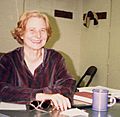Music theory facts for kids
Music theory is like a guide that helps us understand how music is made and how it works. It's all about figuring out the rules and patterns in songs we hear. Someone who studies music theory very deeply is called a music theorist.
People who write music are called composers. People who play or sing music are called performers. Both composers and performers find music theory helpful. It helps them understand why music sounds the way it does.
Long ago, in Ancient Greece, a famous thinker named Pythagoras studied how instruments are tuned. He explored the science of vibrations that instruments make. He also explained why an octave (a set of eight notes) is often divided into twelve smaller parts in some music traditions.
Contents
History of Music Theory
Early Ideas
During the Middle Ages, many important music theorists wrote books about music. Their ideas show us what people thought about music back then. These old writings help us learn about the musical styles of the past.
Music Theory in the 18th Century
In the 1700s, some famous composers also wrote books on music theory. For example, Carl Philipp Emanuel Bach, who was the son of Johann Sebastian Bach, wrote a book called "An Essay on the True Art of Playing the Keyboard." Also, Leopold Mozart, the father of the famous Wolfgang Amadeus Mozart, wrote "The Art of Playing the Violin."
These books were very popular in their time. They taught people how music was played back then. They explained things like how some rhythms were played freely and how ornaments (extra musical decorations) were added.
Studying Music Theory Today
Today, if you want to become a composer, you will likely study music theory. This might happen at a college or university. You would learn about things like harmony (how notes sound good together) and counterpoint (how different melodies fit together). You would also study form, which is the overall structure of a piece of music.
You will learn "rules" in music theory. These are not strict laws. Instead, they describe how most great composers wrote music in the past. These rules explain what composers used to do. They don't tell today's composers exactly what to do. In fact, new music often uses completely different rules!
Music theory is also important for people who perform music. Understanding these ideas helps performers truly connect with the music they are playing. It helps them bring the music to life.
Images for kids
-
Jubal, Pythagoras and Philolaus engaged in theoretical investigations, in a woodcut from Franchinus Gaffurius, Theorica musicæ (1492)
-
A musical canon. Encyclopaedia Britannica calls a "canon" both a compositional technique and a musical form.
-
Tibetan musical score from the 19th century
-
A Classical piano trio is a group that plays chamber music, including sonatas. The term "piano trio" also refers to works composed for such a group.
-
Semiotician Roman Jakobson
-
Columbia University music theorist Pat Carpenter in an undated photo
See also
 In Spanish: Teoría musical para niños
In Spanish: Teoría musical para niños









